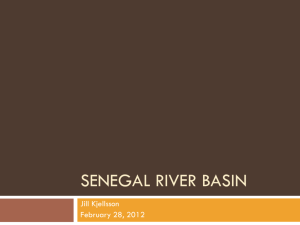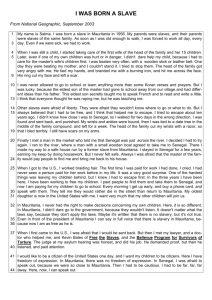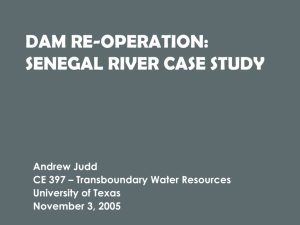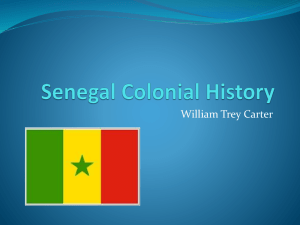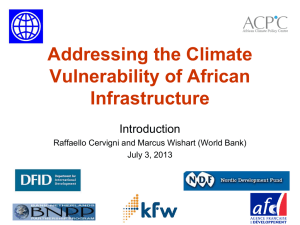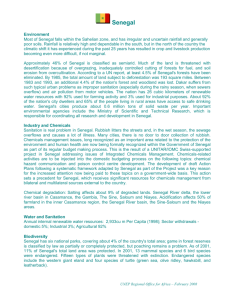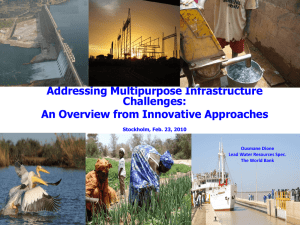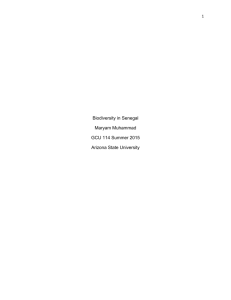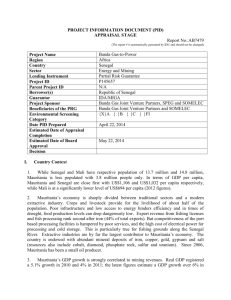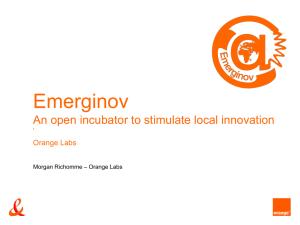1. Senegal River Basin
advertisement
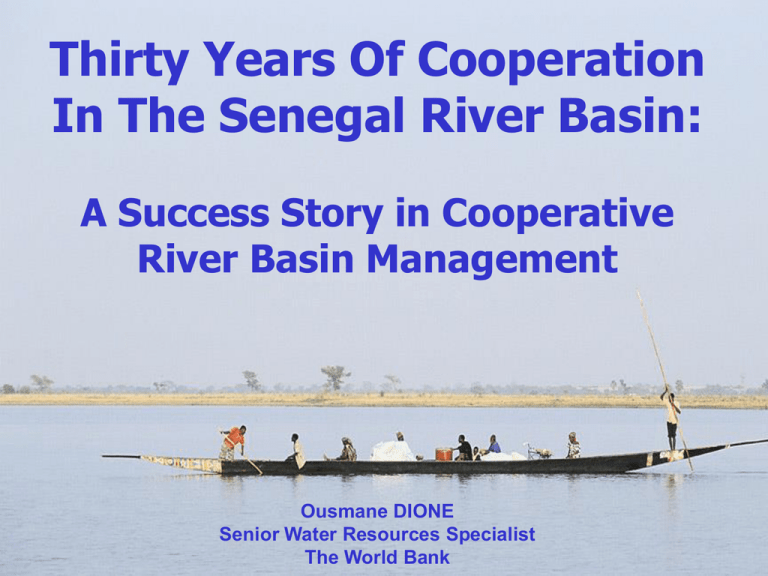
Thirty Years Of Cooperation In The Senegal River Basin: A Success Story in Cooperative River Basin Management Ousmane DIONE Senior Water Resources Specialist The World Bank 1 OVERVIEW 1. The Senegal River Basin: Some references 2. The Underpinning Factors for Crisis 3. History of Cooperation and Institutions 4. The enabling factors for cooperation 5. Key principles for cooperation 6. Sharing benefits from the Senegal River and beyond 7. Lessons and experience 2 “While steel and coal unified Europe, Africa should use its international waters for the same purpose” Alpha Oumar Konare Pdt of the African Union 3 1. The Senegal Basin References • Basin area: 300,000 sq km • River length: 1,800 km formed by three main tributaries: Bafing, Bakoye and Faleme • • Annual discharge approx. 28 km3 Four (4) riparians: (Guinea, Mali, Mauritania and Senegal) ranked among 20 poorest • Population: 12 million in basin; 35 million in 4 countries; • Development: Pour countries exposed to serious shortages 4 1. Senegal River Basin: Factors of Interdependence 5 1. The Senegal River Basin Organization (OMVS): OMVS, an experienced RBO • • • Clear mandate, Vision with innovative tools; Decentralized at national levels; Associated with technical bodies (Permanent Water Commission, Regional Steering Committee, and Environment Observatory); • • • Coupled with autonomous management entities; Familiar with private sector involvement; Even opened to stakeholders participation. 6 2. The Underpinning Factors for Crisis Natural and Man-made: • • • • • • Rainfall variability/droughts and floods; Water scarcity and competing uses; Environmental degradation (deforestation/erosion); Communication/public awareness and outreach; Inadequate land tenure (in the Valley); Water weeds/Waterborne diseases in the Delta; 7 2. The Underpinning Factors for Crisis Countries Stakes Mali • Power and navigation; Mauritania & Senegal • Irrigation and food production + power; Mali, Mauritania & Senegal • Flow information – esp. since commissioning of Manantali; • An awareness (involvement?) in future investments in river in Guinea; Guinea • Hydropower potential at Senegal headwaters; • Protection of upper watershed; • Investments partners; • Energy interconnection; 8 3. History of Cooperation and Institutions COOPERATION (based on shared views and objectives) • • • 1963: Bamako’s convention confers international status to the Senegal River; 1968: First attempt of cooperation with the establishment OERS (all 4 countries). Political divergences failure; 1972: Convention of Nouakchott and creation of the OMVS (Mali, Mauritania and Senegal) but not Guinea; SIX PERMANENT ORGANS (with very clear roles and • • • • • • functions) Conference of Head of States and Government (supreme decisions); Council of Ministers (conception/control); OMVS High Commission (execution of decisions and works); Permanent water commission (PWC: water allocation) Diama Dam Management Holding Company (SOGED); Manantali Dam Management Holding Company (SOGEM). 9 Summit of Heads of State Council of Ministers OMVS High Commission Permanent Organs (Planning, management and consultative) OMVS Mali Local Development Committees OMVS Mauritania OMVS Senegal 4. Enabling Factors for Cooperation Common history cemented by • Cultural and linguistic links (same ethnic groups); Colonial legacy introduced changes with more homogeneity: • • Same official language; Same institutional and legal heritage; Social and economic unity • • Agriculture and livestock are dominant activities; Free trade developed over centuries. 11 5. Key Principles for Cooperation Cooperation based on principles of Solidarity, Equality and Equity: Solidarity refers to: • • • • • Common, Indivisible works and jointly owned infrastructures (1978 convention); Financing joint infrastructures (1982 convention) Joint loans contracted for development purposes; Joint guarantees to reimburse contracted loans and interests; Join management of common infrastructures and assets; Equality means: All decisions are consensus based Equity deals with: • • • Fair allocation of water resources among sectors; Proportional water allocation for irrigation; Joint exploitation of hydroelectricity potential and shared benefits; 12 5. Key Principles for Cooperation (cont’d) Strengths of cooperation: Political legitimacy • Agreements and conventions are signed and ratified by either the Council of Ministers or the Heads of States Conference; • Agreements and conventions take into account good neighborliness and impacts; • Regional integration always seen as element for stability and peace; Challenges of cooperation • Ceding sovereign interests in favor of larger community interests; • Balancing water priorities between sectors; • Environmental standards and enforcement not fully defined and addressed. 13 5. Key Principles for Cooperation (cont’d) Cooperation based on bundling legal instruments: 1972: Convention of Nouakchott and creation of the OMVS (Mali, Mauritania and Senegal) but not Guinea; 1972: Convention on the international status of the Senegal River; 1978: Convention of Bamako on the legal status of the common works (common indivisible property); 1982: Convention on Financing joint infrastructures; 1992: Protocol of accord signed between OMVS&Guinea; 2002: Adoption of the Senegal River Water Charter; 2004: Preparation of the Inclusive framework of the SRB; 14 6. Concrete Achievements 1972-80: OMVS development program (irrigation; hydropower; navigation); 1984: Joint loan from 12 donors to build dams: Manantali (in Mali) and the Diama (Senegal/Mauritania border); 1986: Diama dam operational (blocking salt water intrusion) with an ambitious irrigation program (375 000 ha); 1997: Manantali hydropower dam completed (800 GWH); 2000: Joint dams management bodies established (SOGEDSOGEM) 2002: Jointly owned Power transmission lines connecting the three countries; Private operator (ESKOM, SA) contracted to dispatch the energy produced to national power grids; First basin wide environmental project (four riparian countries included) 2002: 2004: 15 6. Concrete Benefits: From the Senegal River River flow regulation at 300 m3 all over the year enables: • An irrigation potential of 375,000 ha from Manantali dam; • Long term solution for Dakar critical water supply need (1.3 million people in Dakar are now supplied from the Senegal River); • Adequate response to Nouakchott water supply shortage (on going water connection project from the Senegal River); • Groundwater recharge and ecosystems restoration; • River navigation over 900 km from St-Louis (Atlantic Ocean) to Kayes (Mali). 16 6. Concrete Benefits: Beyond the Senegal River Jointly owned 1500 km power transmission lines connecting the three riparian countries power grids from Manantali dam (first WAPP segment): Hydropower share is based on critical needs: • Mali (104 MW or 52%) • Mauritania (30 MW or 15% • Senegal (66 MW or 33%) An optic fiber combined with the transmission lines enables: • Increased telecommunications capacity (30,200 connections), 48 TV channels; • Senegal telecommunication network entirely digital; • Mali and Mauritania linked to the international network; 17 18 6. Beyond the River: Catalyst for Peace and Regional Stability Jointly owned infrastructures act as catalyst for peace: • Diama dam contributed to diffuse the 1989 tension between Senegal and Mauritania; Regional stability enhanced through cooperative framework: • Though in 1989 diplomatic ties were broken, OMVS still functioning as the only viable link between Senegal and Mauritania; Mutual confidence and broad bundled benefits foster regional integration by: • Opening new development opportunities (inter-countries road segments, joint privatization of the Dakar-Bamako railroads, lift of trade barriers, joint environmental actions…); • But some benefits are less obvious than others 19 7. Some Lessons Learned • • • • • • • • • Political will is a key for ownership; Invest in trust and relationship is critical at earlier stage; Commitment and trust must overcome unilateral approach; Common vision is crucial to move forward; Win/win benefits must clearly be perceived to remove win/lose perceptions; Perception of fairness essential to sustain cooperation; Technical preparation is key to understanding the global scope and critical issues; Donors support is important but “no foot print” is essential; Rivers can be obstacles or entry points – both directly and beyond the river; 20 From River cooperation to Regional integration “If only West Africa was a single country. Then, perhaps, we would stand a chance.” 21 Still, Africa’s international rivers challenge: •60+ international rivers •many countries per basin •many basins per country •international relations challenge Thank You
